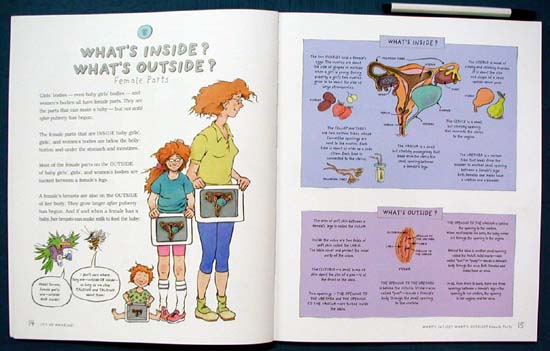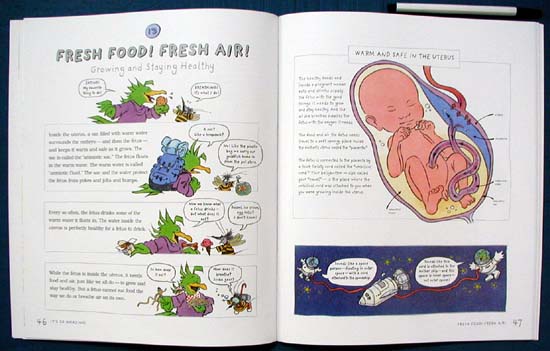|
|
|
|
 |
 이전 | 이전 |  목록 | 다음 목록 | 다음 |
|
|

상세그림 1 |

상세그림 2 |
|
확대 이미지 : 상세그림 1

|
확대 이미지 : 상세그림 2

|
[ 책 소개 ]
* An ALA Notable Book
* A Horn Book Magazine Fanfare Title
* A Children's Cooperative Book Center Choice
* A Children's Literature Choice List Title
Children's Book중에서 베스트셀러이며, 어린이 성교육책중에서 가장 널리 읽히는 책입니다. 저명한 어린이 그림책 Illustrator인 Emberly부부의 아들인 Robert Emberley의 자세하면서도 유머러스한 그림이 자칫 딱딱해지기 쉬운 주제를 쉽고 재미있게 풀어나갑니다.
아기의 탄생, 성장, 남자와 여자의 신체의 차이, 생식기, 사랑과 섹스, 임신 등 어린이들이 갖고 있는 성에 관한 모든 궁금증을 어린이들의 눈높이에 맞춰 그림과 함께 자세히 설명해 줍니다. 즐거움과 놀라움이 가득한 책입니다.
아이가 있는 집은 꼭 소장할 가치가 있는 필수 서적.
고급스런 아트지를 사용한 Large Size의 튼튼한 페이퍼백입니다.
[ 서지 정보 ]
Edition: Paperback: 88 pages
ISBN: 0763613215
책 크기: 30cm x 25cm
[ 영문 서평 ]
From the Publisher
It's So Amazing! was created in response to repeated requests from parents, teachers, librarians, and health professionals for an up-to-date book about sex and sexuality for children who were still too young for It's Perfectly Normal. Once again, the Bird and Bee are up to their antics, but this time they're younger. In It's So Amazing!, these reassuring characters reflect the many moods of children age 7 and up: silly, serious, curious, embarrassed. Their voices echo the thoughts, questions, and concerns of a younger audience.
Synopsis
How an egg and sperm get together and make a baby is a truly amazing story. And that is the main--though not the only--story at the heart of It's So Amazing! A Book about Eggs, Sperm, Birth, Babies, and Families. Comprehensive, honest, and funny, the newest book by Robie Harris and Michael Emberley, author and illustrator of the acclaimed It's Perfectly Normal: Changing Bodies, Growing Up, Sex, and Sexual Health, has been vetted and approved from cover to cover by scientists, health experts, and specialists in child development. A curious Bird and squeamish Bee discuss bodies and babies, adoption and families, plus such topics as puberty, masturbation, homosexuality, HIV and AIDS, and sexual abuse.
Publisher's Weekly
The creators of It's Perfectly Normal, targeted to middle-schoolers, here reach out to a slightly younger audience with candor and humor, neatly distilling various aspects of sex, reproduction and love. An inquisitive, loquacious bird and an embarrassed bee act as comic and straight man and serve as diverting foils to Harris's conversational narrative; kids will both identify with and chuckle at the two characters' reactions and asides. The duo's cheerful banter also clarifies some potentially confusing issues ("So the fetus doesn't grow where the pizza goes!" proclaims the newly enlightened bee). Specific topics covered include changes in boys' and girls' bodies during puberty, intercourse, birth control, chromosomes and genes, adoption and adjusting to a newborn sibling. The roster of experts in the closing acknowledgments speaks to the sensitivity and intelligence with which Harris and Emberley handle their treatment of masturbation, sexual abuse, HIV and AIDS and homosexuality. Emberley's artwork ranges from lighthearted cartoon panels of a talking sperm meeting up with an egg in the fallopian tube to straightforward drawings of reproductive organs and a developing fetus. With its informal yet informed perspective, this volume renders much "amazing" phenomena reassuringly comprehensible.
Children's Literature
A few years ago, this team produced the acclaimed It's Perfectly Normal aimed at kids ages 11 and up. Now they have collaborated on a book that talks about eggs, sperm, birth, babies and families and have targeted it for a younger audience. The book never talks down, the language is accessible and the facts are fairly presented. Harris does not shy away from difficult topics such as homosexuality, HIV and AIDS. Two cartoon characters--a bird and a bee--guide kids through the discussions. There is plenty of humor and a multicultural cast. The subjects of where babies come from and what sex is may be difficult for adults to address, but with this book, they can either talk about the topics with kids or let kids read the book on their own. A good choice for families and libraries.
New York Times Book Review - Colin Harrison
The text recognizes children's feelings and fears, and reassures, line by line, that they are always lovable and always loved, no matter what. Beyond biology, It's So Amazing! is finally about love, and that, we hope, is where babies come from.
Scientific American
Talking to children about where babies come from can be difficult¾on the parents and on the kids. But It's So Amazing might make it a little easier. Give it to your child to read or better yet, sit down and read it together. Interesting discussions are sure to follow. Written in comic-book style, this book addresses many topics, including conception, birth, love, sexuality and family, in a gentle and respectful manner. In the chapter "Becoming a Family," for example, a variety of families are mentioned, including those headed by a single parent, by parents who are gay or straight, and by parents who are married or divorced. Illustrations help validate each combination as a real and loving family. In a direct and nonthreatening manner, Harris discusses cesarean births, premature babies, adoption, sexual abuse, and HIV and AIDS. Colorful drawings depict people of different cultures, races, shapes and sizes. An eager-to-learn bird and a more reticent bee serve as an audience within the book. They ask questions, make comments and learn along with the reader. Offering comic relief throughout, they also help readers recognize that not everyone shares the same comfort level discussing these issues and that however one feels is okay. This is a book you'll wish someone had given you as a child.
Booklist
The author and illustrator duo that broke new ground with their frank talk and depiction of puberty and changing bodies in It's Perfectly Normal, (1994) returns with an equally outstanding book. It's for children who may have "noticed kids who are going through puberty" but are not there themselves and have questions about sex and "where babies come from." The simple and straightforward prose focuses on reproduction and birth, including information on eggs, sperm, male and female body parts, the multiple meanings of sex, fetal development and delivery, family composition, and "okay touches" and "not okay touches." Related issues such as puberty, sexual orientation, birth control, and AIDS receive less detailed attention. The text is browser friendly; important information and reassuring words are repeated. Harris is also very good at recognizing children's misconceptions and teams up with Emberley to address myths in humorous ways: one illustration clears up the confusion over where the pizza goes (in the mother's stomach) and where the baby grows (in the uterus, or womb). The inquisitive bird and the embarrassed bee of the first book are back, but in more prominent roles as commentators, word definers and pronouncers, and official punsters. The bold, colorful illustrations fill the pages and are not as graphic as in the previous book. With the exception of two pages showing male and female bodies from infancy to older adulthood, examples feature clothed children and adults, and comic-strip art chronicles the amazing adventures of egg and sperm. A welcome book that meets the needs of those in-between or curious kids who are not ready, developmentally or emotionally, for It's Perfectly Normal.
Kirkus Reviews
Harris and Emberley fill the gap between their picture book, Happy Birth Day (1996), and the instant-classic It's Perfectly Normal (1994) with this equally sensitive, good-humored take on love and sex, puberty, genetics, pregnancy, and related topics, from sibling rivalry to HIV. Emberley supplies side (and snide) commentary from an eager bird and a reluctant bee to go along with cartoon depictions of anatomical details, human figures in a marvelous variety of ages, shapes, and skin colors, and a dramatic sequence covering fetal development from one month to nine in actual size. Never talking down to readers, Harris takes wide-angled views of sexual preferences, birth control, and the meaning of ``family,'' while making the terminology less forbidding by mixing it with familiar comparisons: ``The epididymis is a long, twisty, coiled tube. It is shaped somewhat like a telephone receiver, but smaller.'' The collaborators expertly walk the line between frankness and bluntness, keeping the actual sex act under the covers, and nimbly explaining how abuse differs from normal human contact and affection. Closing on a cheery note with a look at new baby customs in several parts of the world, this provides sensible, reassuring answers to readers' questions and concerns, and interrupts the rain of information with occasional silliness. (index)
Perri Klass, M.D., Parenting contributing editor and Medical Director of Reach Out and Read
Provides an opportunity for children to find answers to their questions, with clarity of explanation, fabulous illustrations, and humor, together with [its] all-important sense of wonder.
Berry Brazelton, M.D., author of Touchpoints
This thoughtful, innovative, and comprehensive book helps children with issues that are on their minds anyway and gives all of us the language we need to share with them.
Alvin F. Poussaint, M.D., consultant for The Cosby Show, Clinical Professor of Psychiatry, Harvard Medical School
An excellent resource on sex education for young children . . . A book every family should own.
|
| * 작가의 다른 작품(1) |
Who? A Celebration of Babies - 보드북, 슈퍼바이
Who? A Celebration of Babies
보드북, 슈퍼바이 |
| * 최근 이 작품을 구입하신 분들의 다른 선택 |
Hoot
뉴베리 수상도서, 페이퍼백 |
Nate the Great and the Missing Birthday Snake
네이트 더 그레이트, 페이퍼백 |
In New York
큰 사이즈 하드커버, 슈퍼바이 |
Houses and Homes
페이퍼백, 슈퍼바이 |
|
| |
|
|< << [1] [2] [3] [4] [5] [6] [7] [8] [9] [10] >> >|
|
|
|